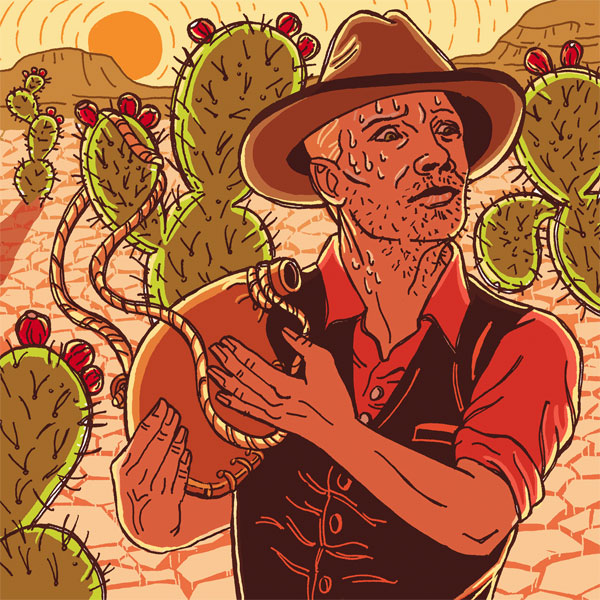Overdraft Fees
Here’s how the strategy works: The system is based on four drought levels—advisory, watch, warning and emergency. These stages are set in motion when the utility forecasts it will overpump a certain amount of water from the aquifer beneath the city. Each requires progressively more serious conservation measures.Jensen says he’s concerned the revised drought strategy does not contain the same protections for the aquifer—or the same clear guidelines. "With these changes it would be extremely difficult to get a drought declaration that required the utility to respond adequately. The conservation measures are not tied to any drought level."Water Authority spokesperson David Morris says the strategy that’s in place is outdated and includes restrictions the utility doesn’t have the power to enforce. For example, it prescribes telling people to shut down decorative ponds or fountains in times of drought, says Morris. That’s a rule the city might be able to impose but not the utility. "We think the proposed update addresses the issues that made the old strategy problematic. It no longer includes responses that we are not legally allowed to undertake and establishes goals in much clearer terms," he says. The utility is also looking at more customer-friendly ways to achieve water savings, he says. While restrictions and penalties will remain, incentives are being offered, too.Under today’s strategy, each drought stage is triggered when the city’s going to use more aquifer water than planned. An advisory is triggered when 10,000 acre-feet of excess pumping is expected, and so on in 10,000 acre-foot increments. (An acre-foot is about 325,851 gallons of water. Imagine an acre field covered a foot deep in water. Now imagine 10,000 of them.)An advisory requires only increased public education about voluntary conservation steps. A watch demands citizens water their yards only three days a week, reduce the size of the turf at institutional buildings by 15 percent, restrict watering on impervious surfaces and eliminate curbside car washes. It also forbids the use of water for aesthetic purposes, such as in fountains and refill ponds. When a watch is in effect, surcharges double for excess use and waste. A warning includes even higher restrictions and a triple surcharge.So, as written, the strategy puts an emphasis on not overpumping the aquifer. It states that it shares this latter goal with the San Juan-Chama Drinking Water Project. The project routes flow from the Colorado Basin to the Rio Grande for use by the city to supplement aquifer water.By 2040 it is projected "the city will need to find other water sources to avoid permanent damage to the aquifer," the strategy reads. "Greater-than-projected pumpage can be viewed as an overdraft on a limited underground water account." Drought measures are intended to pay back an overdraft.Ash in the River
Jensen says his recent dealings with the utility’s staff don’t give him much confidence in their plans for the revision. Throughout the last year, he has attempted—unsuccessfully—to use the drought management strategy to argue for increased conservation measures. An advisory was issued in May. In September, the utility announced it was stopping all surface-water diversion during September and October because of forest-fire ash in the river and low river flows. Jensen told the utility’s governing board it should consider raising the level to warning. But the board rejected that idea at its Oct. 19 meeting and voted to delay considering increased drought levels until April. At the same meeting, the utility’s executive director, Mark Sanchez, told the board the utility would revise the drought management strategy. Jensen insisted that the public at large should have a chance to comment on it.Morris explains that start-up problems at the utility’s surface water treatment plant and unexpected events like forest fires upstream resulted in a varying supply of surface water. This made it difficult to set a goal for pumping aquifer water and, therefore, difficult to estimate when overpumping will occur. But problems with the plant should not trigger a strategy meant to deal with a weather condition, he says, which is one reason the drought management strategy is being revised. "I think it’s important to distinguish between the drought management strategy and the overall conservation strategy," he says.He also notes that under the new plan, the utility would publicly set annual water conservation goals.Morris says the public is invited to provide input on the changes at two of the utility’s Citizens Advisory Committee meetings, Dec. 1 and Jan. 5. Copies of the draft revision will be distributed at the meetings. However, those interested should check the utility’s website in case meetings are canceled or postponed. A final draft should be in front of the board in early 2012, he says.Proposed Drought Rules
Customer Advisory Committee Meetings
Thursday, Dec. 1Thursday, Jan. 54 p.m.Albuquerque Bernalillo County Government CenterRoom 50381 Civic Plaza NWbit.ly/waterCAC




